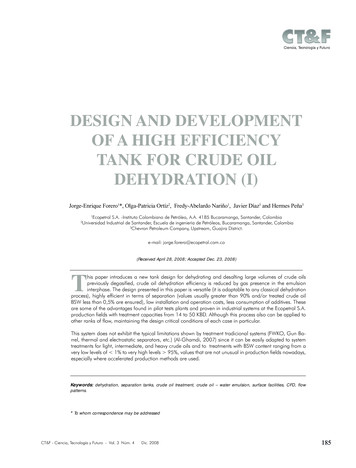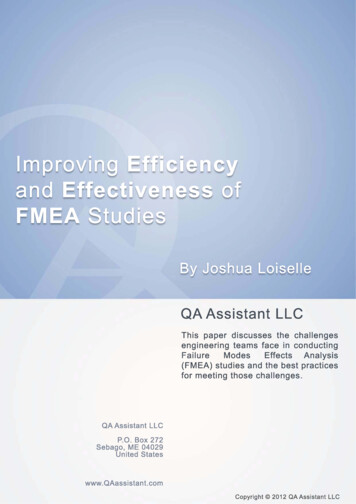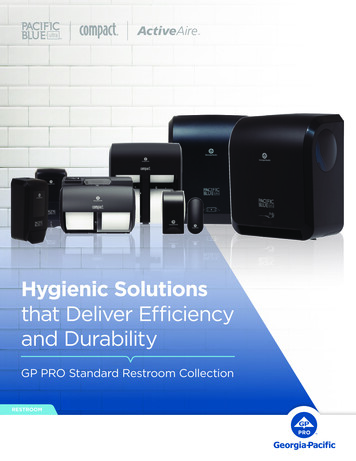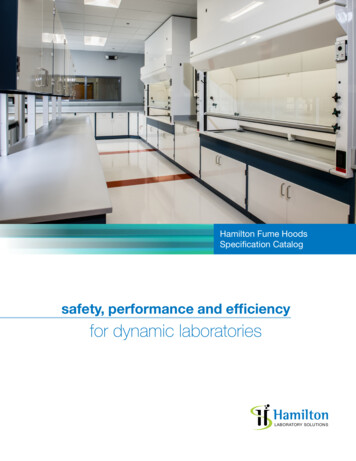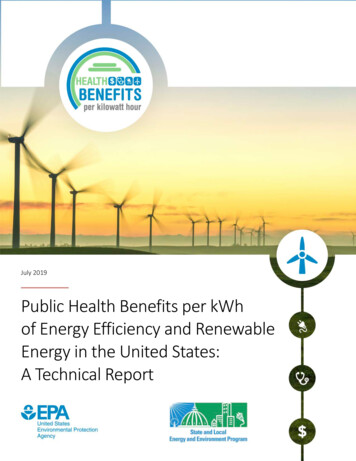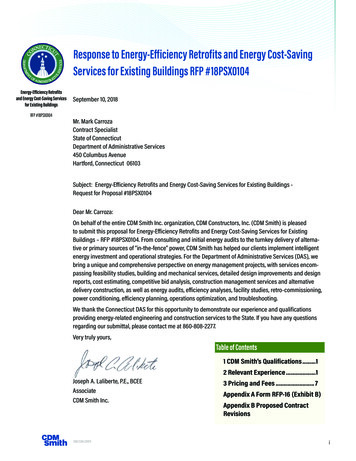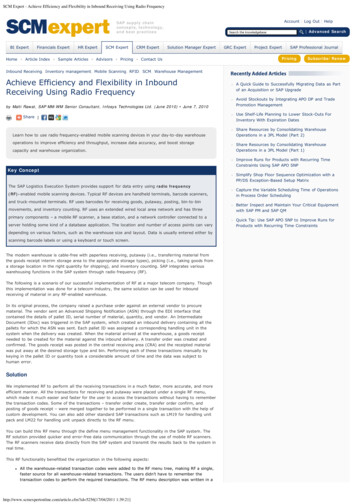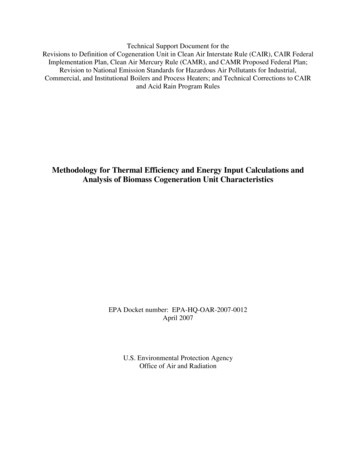
Transcription
Technical Support Document for theRevisions to Definition of Cogeneration Unit in Clean Air Interstate Rule (CAIR), CAIR FederalImplementation Plan, Clean Air Mercury Rule (CAMR), and CAMR Proposed Federal Plan;Revision to National Emission Standards for Hazardous Air Pollutants for Industrial,Commercial, and Institutional Boilers and Process Heaters; and Technical Corrections to CAIRand Acid Rain Program RulesMethodology for Thermal Efficiency and Energy Input Calculations andAnalysis of Biomass Cogeneration Unit CharacteristicsEPA Docket number: EPA-HQ-OAR-2007-0012April 2007U.S. Environmental Protection AgencyOffice of Air and Radiation
Technical Support Document for Proposed Revisions to Cogeneration Definition in CAIR, CAIRFIP, CAMR, and Proposed CAMR Federal PlanThis Technical Support Document (TSD) has several purposes. One purpose of the TSD is to setforth the methodology for determining the thermal efficiency of a unit for purposes of applyingthe definition of the term “cogeneration unit” under the existing CAIR, the CAIR model tradingrules, the CAIR FIP, CAMR, the CAMR Hg model trading rule, and the proposed CAMRFederal Plan. Another purpose of the TSD is to present information relevant to the proposedrevisions, and other potential revisions for which EPA is requesting comment, concerning thethermal efficiency standard. One of the critical values used in the determination of thermalefficiency is the “total energy input” of the unit. Consequently, in connection with setting forththe methodology for determining thermal efficiency, the TSD specifically addresses whatformula is to be used in calculating a unit’s total energy input under the existing rules.There are two major issues concerning the calculation of total energy input. The first issue iswhether, under the existing rules, total energy input is determined based on the higher or lowerheating value of the fuel or fuels combusted in the unit and how to calculate heating value. Asdiscussed below, EPA maintains that, under the existing rules, total energy input constitutes thelower heating value of the fuel or fuels combusted by the unit, and EPA is requesting commenton whether the existing rules should be revised to state explicitly the formula for calculating totalenergy input using lower heating value. The second issue is whether and to what extent theexisting rules should be revised to exclude non-fossil fuel (such as biomass) from the calculationof total energy input. As discussed below, EPA is requesting comment on the proposed revision,and other potential revisions, concerning such exclusion. EPA is not requesting comment on anyother aspects of the thermal efficiency standard such as, for example, the adoption of a standardas part of the definition of the term “cogeneration unit,” the specific percentages of total energyoutput that must be met, or the treatment of useful thermal energy in the thermal efficiencystandard.Another purpose of the TSD is to address the information that EPA has developed concerningthe units potentially affected by the proposed change to the existing rules concerning the extentto which non-fossil fuel should be excluded from the calculation of a unit’s total energy input.As discussed in the preamble of the proposed rule for which this TSD is provided, EPA has taken1
Technical Support Document for Proposed Revisions to Cogeneration Definition in CAIR, CAIRFIP, CAMR, and Proposed CAMR Federal Plana number of steps to gather the most complete information we could about the number, size,location, industry, fuel use, electricity sales, and environmental impacts of the units potentiallyaffected by the proposed change concerning the exclusion of non-fossil fuel from the calculationof total energy input. The TSD provides more detailed information about the biomasscogeneration unit inventory, data sources, and emissions calculations that EPA used in itsanalysis for the proposed rule.I. Thermal Efficiency and Total Energy InputIn this section of the TSD, EPA describes the methodology for calculating thermal efficiency ofa unit in order to help determine whether the unit qualifies for the cogeneration unit exemption.In addition, EPA addresses the definition and calculation of “total energy input,” which is usedin calculating thermal efficiency in order to determine whether the unit qualifies for thecogeneration unit exemption.A. Determining Thermal EfficiencyIn CAIR, the CAIR model trading rules, the CAIR FIP, CAMR, the CAMR Hg model tradingrule, and the proposed CAMR Federal Plan, EPA included, as one criterion that a unit must meetin order to potentially qualify for the cogeneration unit exemption, the requirement that the unitmeet a thermal efficiency standard. In adopting a thermal efficiency standard, EPA decided touse the thermal efficiency standard adopted by the Federal Energy Regulatory Commission(FERC) in determining whether a unit is a qualifying cogeneration unit under section (3)(18)(B)of the Federal Power Act (as amended by the Public Utility Regulatory Policy Act (PURPA)).However, EPA decided to make the thermal efficiency standard applicable to all fuels combustedby a unit, while the FERC limited application of the standard to natural gas and oil. (See 18 CFR292.205(a)(2) and (b)(1). See 70 FR 25277).The methodology for determining thermal efficiency adopted by EPA in the existing rules can berepresented as the following:Thermal Efficiency (Net Electric Output Net Thermal Output/2)/Fuel Heat Input (LHV)2
Technical Support Document for Proposed Revisions to Cogeneration Definition in CAIR, CAIRFIP, CAMR, and Proposed CAMR Federal PlanMore background on the decision to use a thermal efficiency standard and how to perform thethermal efficiency calculation can be found in the “Cogeneration Unit Efficiencies Calculation”TSD for CAIR.1B. Calculating Total Energy Input1. Higher Heating Value vs. Lower Heating ValueA critical value used in applying the thermal efficiency standard is the “total energy input” forthe year for which thermal efficiency is being calculated. One of the first steps in determiningthe total energy input for a unit is identifying the unit’s fuel mix and the heat content or heatingvalue of the fuel or fuels combusted by the unit. Heating value, commonly expressed in Btu, canbe measured in several ways, but the most common are to use gross heat content (referred to as“higher heating value” or “HHV”) or to use net heat content (referred to as “lower heating value”or “LHV”). According to the Energy Information Administration (EIA) of U.S. Department ofEnergy, higher heating value includes, while low heating value excludes, “the energy used tovaporize water (contained in the original energy form or created during the combustionprocess).”2As discussed above, EPA adopted in the existing rules the same thermal efficiency standard asthat adopted by FERC in determining whether a unit is a qualifying cogeneration unit, exceptthat EPA applied the thermal efficiency standard to all fuels and the FERC limited application ofthe standard to natural gas and oil. FERC’s regulations that included the thermal efficiencystandard stated that “energy input” in the form of natural gas and oil “is to be measured by thelower heating value of the natural gas or oil.” See 18 CFR 292.202(m). As explained by FERCwhen it adopted these regulations in 1980 (45 FR 17959, 17962 (1980)):Lower heating values were specified in the proposed rules in recognition of the fact thatpractical cogeneration systems cannot recover and use the latent heat of water vaporformed in the combustion of hydrocarbon fuels. By specifying that energy input to a1Cogeneration Unit Efficiencies Calculation, March 2005. OAR-2003-0053-2087http://epa.gov/cair/pdfs/tsd cogen.pdf2http://www.eia.doe.gov/glossary/glossary h.htm3
Technical Support Document for Proposed Revisions to Cogeneration Definition in CAIR, CAIRFIP, CAMR, and Proposed CAMR Federal Planfacility excludes energy that could not be recovered, the commission hoped that theproposed energy efficiency standards would be easier to understand and apply.Because the thermal efficiency standard on which EPA’s thermal efficiency standard was basedis premised on using LHV to determine total energy input, EPA believes that the thermalefficiency standard in the existing CAIR, CAIR model trading rules, CAIR FIP, CAMR, CAMRHg model trading program, and the proposed CAMR Federal Plan should be interpreted assimilarly requiring the use of LHV of all fuels combusted at the unit in calculating a unit’s totalenergy input. EPA notes that, if a unit uses HHV for the calculations and meets the thermalefficiency standard on that basis, the unit would necessarily meet the standard using LHV. See45 FR 17962.2. Definition of Lower Heating Value (LHV)Although FERC regulations use lower heating value to measure a unit’s energy input fromnatural gas and oil, the regulations do not specify a formula for calculating lower heating value.While there may be alternative definitions of, or formulas for calculating, LHV, EPA maintainsthat the following formula is consistent with the FERC approach for calculating LHV of fuels byexcluding from the higher heating value of such fuels “the latent heat of water vapor formed inthe combustion of hydrocarbon fuels.” See 45 FR 17962. Under this formula, the relationshipbetween the lower heating value of a fuel and the higher heating value of that fuel is:LHV HHV – 10.55(W 9H)Where:LHV lower heating value of fuel in Btu/lb,HHV higher heating value of fuel in Btu/lb,W Weight % of moisture in fuel, andH Weight % of hydrogen in fuel.EPA believes that the existing CAIR, CAIR model trading rules, CAIR FIP, CAMR, CAMR Hgmodel trading rule, and the proposed CAMR Federal Plan should be interpreted to require use ofthis formula for calculating lower heating value for purposes of determining total energy input.4
Technical Support Document for Proposed Revisions to Cogeneration Definition in CAIR, CAIRFIP, CAMR, and Proposed CAMR Federal PlanThis formula is consistent not only with the description of “lower heating value” by FERC, butalso with EIA’s description of the term. Moreover, the formula reflects a standard approach tocalculating lower heating value. See the International Flame Research Foundation CombustionHandbook, http://www.handbook.ifrf.net (IFRF 1999-2000) (discussing relationship betweenhigher and lower calorific value of a fuel).EPA is requesting comment on the methodology described above for determining a unit’sthermal efficiency (i.e., on the use of lower heating value in the denominator of the equation forthermal efficiency) and on the above-described formula for calculating LHV to determine aunit’s total energy input, under the existing regulations. In addition, EPA is considering addinglanguage to the existing regulations specifying this formula for calculating total energy input forpurposes of applying the thermal efficiency standard. In particular, EPA is considering revisingthe definition of “total energy input” in the existing CAIR, CAIR model trading rules, CAIR FIP,CAMR, CAMR Hg model trading rule, and proposed CAMR Federal Plan by adding thefollowing language to that definition:The energy input of any form of energy shall be measured by the lower heating value of thatform of energy calculated as follows:LHV HHV – 10.55(W 9H)Where:LHV lower heating value of fuel in Btu/lb,HHV higher heating value of fuel in Btu/lb,W Weight % of moisture in fuel, andH Weight % of hydrogen in fuel.As discussed in the preamble of the proposed rule for which this TSD is provided, EPA requestscomment on whether the formula for calculating lower heating value shown above should beadded to the existing regulations or whether some alternative formula for calculating total energyinput or lower heating value is appropriate and should be added to the existing regulations.5
Technical Support Document for Proposed Revisions to Cogeneration Definition in CAIR, CAIRFIP, CAMR, and Proposed CAMR Federal Plan3. Fuels to Include in Total Energy InputIn the rulemaking for which this TSD is provided, EPA is proposing to revise the thermalefficiency standard, as applied to certain existing units, to include in “total energy input” only theenergy input from fossil fuel combusted by the units, rather than energy input from all fuelscombusted. This change would make it more likely that those existing units that burn biomassand cogenerate electricity and useful thermal energy (referred to herein as “biomass cogenerationunits”) could meet the thermal efficiency standard and qualify as exempt cogeneration unitsunder these rules. As discussed in the preamble of the rulemaking for which the TSD isprovided, EPA is requesting comment on the proposed revision and on an alternative underwhich “total energy input” would instead be defined to include energy input from all fuelscombusted, except biomass.II. Units Affected by the Proposed Rule ChangeThis section of the TSD discusses the approach EPA used to estimate the universe ofcogeneration units potentially affected by the proposed rule. As explained in more detail below,we used several data sources and selection criteria to develop a list of units, estimate which unitswould possibly be affected by a rule change, and what the environmental impacts might be.These inventory lists of identified biomass cogeneration units represent EPA’s best effort toidentify biomass cogeneration units that meet the specified criteria, but should not be assumed tobe all inclusive or a determination of rule applicability.A. Inventory Criteria and InformationTo start, EPA wanted to know more about the population of biomass cogeneration units currentlyin use and their characteristics. We defined the appropriate criteria for the cogeneration unitsand then applied the criteria to help identify units that would potentially be included in CAIRand/or CAMR. The final inve
Thermal Efficiency (Net Electric Output Net Thermal Output/2)/Fuel Heat Input (LHV) Technical Support Document for Proposed Revisions to Cogeneration Definition in CAIR, CAIR FIP, CAMR, and Proposed CAMR Federal Plan 3 More background on the decision to use a thermal efficiency standard and how to perform the thermal efficiency calculation can be found in the “Cogeneration Unit .
